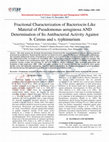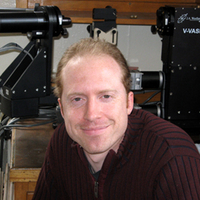Papers by Ashish Kumar Patel
This paper describes the design flow, fabrication 3D printing, assembly and embedded system desig... more This paper describes the design flow, fabrication 3D printing, assembly and embedded system design for constructing a portable centrifuge for laboratory applications. The main goal is to reduce the cost of commercially available centrifuges using additive manufacturing technology. The embedded controller allows for electronic control of the functionality of the centrifuge. The designed system also includes temperature and moisture sensors to provide additional data to the user. The low weight and compact design allows for assembly as per the user requirement.
This paper presents the preliminary development of efficient control module for battery charging ... more This paper presents the preliminary development of efficient control module for battery charging and monitoring. While designing a charging system for battery some parameters must be considered such as the state of charge, lifecycle of battery and charging time. These parameters are monitored and controlled with the help of Atmega microcontroller. This embedded module is interfaced with charging module for the battery. The battery used in this work is a lead acid battery. A two stage charging technique, includes combination of constant current and constant voltage source which is used to charge lead acid battery. Index Terms Batteries, Constant Current Mode, Constant Voltage Mode, Lead Acid Battery, Microcontroller, Thermal Management
The presented work demonstrates the simulation of Graphene Transistor. Graphene filed effect tran... more The presented work demonstrates the simulation of Graphene Transistor. Graphene filed effect transistor can be operated at high-frequency. The material parameters for device simulation have been extracted from the recently published literature. The device carrier transport calculations are performed with semiclassical Boltzmann transport models along with Poisson equations. The current-voltage characteristics analyzed and performance of the device is evaluated. Device parameters of the graphene radio frequency transistor have been extracted. The equivalent circuit has been built with passive components by using general purpose PSpice circuit simulator. Then the equivalent circuit performance is analyzed for a given input frequency.
2018 2nd International Conference on Electronics, Materials Engineering & Nano-Technology (IEMENTech), 2018
This work is about synthesis and characterization of Zinc Oxide nanomaterials for developing sens... more This work is about synthesis and characterization of Zinc Oxide nanomaterials for developing sensing layers. These layers are developed for sensing gases. The methodology is Ultrasonic probe method based on top-down approach. Ultrasonic waves are used to grind down macro-sized metal oxides to nano dimensions. The synthesized material is characterized using Electron microscopy, Spectroscopy, and Diffraction studies. The results are interpreted with respect to electric properties for exploration of sensitivity.
2019 IEEE International Conference on Electrical, Computer and Communication Technologies (ICECCT), 2019
A new approach for sensing temperature change in biological tissue by using 3D printed prototypes... more A new approach for sensing temperature change in biological tissue by using 3D printed prototypes has proposed. The temperature change on the surface of tissue was measured at different wavelength of light. LM35, Thermistor, Light Dependent Resistor (LDR) and Photodiode were used as sensing element in the prototype. The experiment was conducted at room temperature and maintained the surrounding temperature at 37 ± 2 °C. The temperature change in solutions with different concentrations of salt and sugar were measured using sensing prototypes. Multiple graphs are plotted to compare temperature changes with respect to time and light intensities.
2017 1st International Conference on Electronics, Materials Engineering and Nano-Technology (IEMENTech), 2017
Synthesis of Silver nanoparticles using silver nitrate as metal salt precursor and citric acid as... more Synthesis of Silver nanoparticles using silver nitrate as metal salt precursor and citric acid as reducing agent is being reported in this paper. Using Spectroscopy, silver nanoparticles nucleation and growth parameter has been analyzed. Absorption spectra of silver nanoparticles in water are determined. Absorption spectra shows two absorption peaks while crystal was growing, whereas fully grown crystal shows single absorption peak confirms heterogeneous crystal growth in liquid medium and average size distribution of silver nanoparticles.
IETE Journal of Research, 2018
Tin-oxide-based metal oxide nanoparticles synthesis method and characterization results are repor... more Tin-oxide-based metal oxide nanoparticles synthesis method and characterization results are reported. These tin-oxide nanoparticles have been synthesized using the ultrasonic probe method. The morphology and surface characteristics of synthesized nanoparticles have been analyzed through electron microscopy and X-ray diffraction technique. The sensitivity of carbon dioxide gas detection has been tested using a sensing layer prototype.
International Journal of Applied Engineering Research , 2019
Currently, synthesis of nanomaterials requires different types
of glassware like burettes and pip... more Currently, synthesis of nanomaterials requires different types
of glassware like burettes and pipettes to control the flow rate
of precursors during chemical reactions. Contemporary
methods are found to be time consuming and inefficient to
deliver the precise volume of precursor solution at a particular
flow rate into the reaction mixture. To make precise delivery
of fluids at a fixed flow rate, the design and development of a
customized infusion pump is reported in this work. This
includes the design of the system, 3D-printing of the parts,
assembly of the spare parts and automation of the infusion
pump using microcontrollers. Further, the synthesis of zinc
oxide nanomaterial by conventional methodology and using
the designed prototype has been compared and reported.
www.ijrar.org (E-ISSN 23481269, P- ISSN 2349-5138), 2019
This paper discusses the development of preliminary module of a single rotor unmanned aerial vehi... more This paper discusses the development of preliminary module of a single rotor unmanned aerial vehicle based paramotor for energy efficient long distance surveillance. It describes the experimental implementation of landing assistance for the vehicle. An ultrasonic sensor is used to demonstrate the landing sequence in the developed prototype. The prototype design is fabricated using a propeller, brushless dc motor and electronic speed controller. This is mounted on the hollow cylindrical pipe with the base support comprising of ultrasonic sensor interfaced with the microcontroller. Depending on the distance of obstacle from the sensor, the rotor speed is controlled.
2nd International Conference on Electronics, Materials Engineering & Nano-technology, 2018(IEEE), 2018
This work is about synthesis and characterization
of Zinc Oxide nanomaterials for developing sens... more This work is about synthesis and characterization
of Zinc Oxide nanomaterials for developing sensing layers. These
layers are developed for sensing gases. The methodology is
Ultrasonic probe method based on top-down approach.
Ultrasonic waves are used to grind down macro-sized metal
oxides to nano dimensions. The synthesized material is
characterized using Electron microscopy, Spectroscopy, and
Diffraction studies. The results are interpreted with respect to
electric properties for exploration of sensitivity.

International Journal of Science, Engineering and Management (IJSEM), 2017
Abstract: This study presents the fractional characterization of bacteriocin-like material (Inhib... more Abstract: This study presents the fractional characterization of bacteriocin-like material (Inhibiting molecule showing properties
of bacteriocin) produced by Bacteriocin-like material was found to be active against Bacillus cereus and Salmonella typhimurium..
The maximum antibacterial activity of Pseudomonas aeruginosa was recorded at 16th hour incubation in nutrient broth at 370C.
The antibacterial activity was found to be extracellular since, cell-free supernatant showed inhibition against test organism. The
inhibitor was found to have proteinaceous nature and same has been confirmed by inactivation of inhibitor after addition of
proteolytic enzymes (trypsin and proteinase K) and 0.2N NaOH for alkaline hydrolysis. After prolonged refrigeration and
incubation at high temperature (600C, 1200C and under autoclave) for 15 minutes, inhibitor was found to be active against
Bacillus cereus and Salmonella typhimurium. Therefore, inhibitor produced by the Pseudomonas aeruginosa can be bacteriocinlike
material and may find application in medicine and in minimally processed food stuffs.
1st International Conference on Electronics, Materials Engineering & Nano-technology (IEMENTECH), 2017
Synthesis of Silver nanoparticles using silver
nitrate as metal salt precursor and citric acid as... more Synthesis of Silver nanoparticles using silver
nitrate as metal salt precursor and citric acid as reducing agent is
being reported in this paper. Using Spectroscopy, silver
nanoparticles nucleation and growth parameter has been
analyzed. Absorption spectra of silver nanoparticles in water are
determined. Absorption spectra shows two absorption peaks
while crystal was growing, whereas fully grown crystal shows
single absorption peak confirms heterogeneous crystal growth in
liquid medium and average size distribution of silver
nanoparticles.
IETE Journal of Research, 2018
Tin-oxide-based metal oxide nanoparticles synthesis method and characterization results are
repor... more Tin-oxide-based metal oxide nanoparticles synthesis method and characterization results are
reported. These tin-oxide nanoparticles have been synthesized using the ultrasonic probe method.
The morphology and surface characteristics of synthesized nanoparticles have been analyzed
through electron microscopy and X-ray diffraction technique. The sensitivity of carbon dioxide gas
detection has been tested using a sensing layer prototype.
International Journal of Research and Analytical Reviews (IJRAR), 2019
This paper describes the process steps involved in development of a low cost portable overhead mi... more This paper describes the process steps involved in development of a low cost portable overhead mixer used in biotechnology and material science laboratories. The mixer geometry and structure is designed in CAD tool. The structures of the mixer are fabricated using 3D printers. This portable mixer is operated with DC as well as AC supply. The operations are electronically controlled using customized embedded system unit. The mixer can also be operated using mobile interface.
International Journal of Applied Engineering Research, 2019
Copper oxide nanofluids are prepared using two -step process is being reported. Nanoparticles wer... more Copper oxide nanofluids are prepared using two -step process is being reported. Nanoparticles were synthesized by chemothermal method with surfactant used as capping agent. Scanning electron microscopic image and X-Ray Diffraction result confirms the morphology and crystalline structure of the copper oxide nanoparticles. Well dispersed copper oxide nanofluids were obtained which would be further used in development of engine cooling system.
International Journal of Applied Engineering Research, 2019
This paper describes the design sequence, 3D printing of instrument parts and electronic control ... more This paper describes the design sequence, 3D printing of instrument parts and electronic control system design for a pellet mixer. The work includes design of printable files, geometric design, and embedded system design for mobile control of the instrument. The assembled portable instrument functionality can be controlled through a smart phone from any location.
International Journal of Research in Advent Technology, 2018
This paper outlines the methodology and fabrication process involved in the design of a vortex mi... more This paper outlines the methodology and fabrication process involved in the design of a vortex mixture. The parts of the mixer are designed in CAD/CAM tool and additively printed with 3D printer. A microcontroller based control system is designed for controlling the rotator speed.
International Journal of Applied Engineering Research, 2019
This paper describes the design flow, fabrication 3D printing, assembly and embedded system desig... more This paper describes the design flow, fabrication 3D printing, assembly and embedded system design for constructing a portable centrifuge for laboratory applications. The main goal is to reduce the cost of commercially available centrifuges using additive manufacturing technology. The embedded controller allows for electronic control of the functionality of the centrifuge. The designed system also includes temperature and moisture sensors to provide additional data to the user. The low weight and compact design allows for assembly as per the user requirement.
International Journal of Research and Analytical Reviews (IJRAR), 2019
This paper presents the preliminary development of efficient control module for battery charging ... more This paper presents the preliminary development of efficient control module for battery charging and monitoring. While designing a charging system for battery some parameters must be considered such as the state of charge, lifecycle of battery and charging time. These parameters are monitored and controlled with the help of Atmega microcontroller. This embedded module is interfaced with charging module for the battery. The battery used in this work is a lead acid battery. A two stage charging technique, includes combination of constant current and constant voltage source which is used to charge lead acid battery.
International Journal of Research in Advent Technology, 2018
Two different types of Graphene Nanomesh Field Effect Transistor has been tested with aluminum ox... more Two different types of Graphene Nanomesh Field Effect Transistor has been tested with aluminum oxide (Al2O3) and Tantalum (Ta) as a gate dielectric materials. Graphene Nanomesh bandgap is engineered with Virtual NanoLab (ATK). The material parameters such as channel thickness and width of Graphene Nanomesh Filed Effect Transistor are extracted. The transistor operation is modeled with Drift-Diffusion Model Space (DDMS). The two different transistor devices are analyzed by applying various gate bias voltages. The transfer and output characteristics are observed. The functionality of the transistors are calculated for high frequency input signals. The maximum frequency is observed for aluminum oxide top-gated dielectric Graphene Nanomesh Filed Effect Transistor.









Uploads
Papers by Ashish Kumar Patel
of glassware like burettes and pipettes to control the flow rate
of precursors during chemical reactions. Contemporary
methods are found to be time consuming and inefficient to
deliver the precise volume of precursor solution at a particular
flow rate into the reaction mixture. To make precise delivery
of fluids at a fixed flow rate, the design and development of a
customized infusion pump is reported in this work. This
includes the design of the system, 3D-printing of the parts,
assembly of the spare parts and automation of the infusion
pump using microcontrollers. Further, the synthesis of zinc
oxide nanomaterial by conventional methodology and using
the designed prototype has been compared and reported.
of Zinc Oxide nanomaterials for developing sensing layers. These
layers are developed for sensing gases. The methodology is
Ultrasonic probe method based on top-down approach.
Ultrasonic waves are used to grind down macro-sized metal
oxides to nano dimensions. The synthesized material is
characterized using Electron microscopy, Spectroscopy, and
Diffraction studies. The results are interpreted with respect to
electric properties for exploration of sensitivity.
of bacteriocin) produced by Bacteriocin-like material was found to be active against Bacillus cereus and Salmonella typhimurium..
The maximum antibacterial activity of Pseudomonas aeruginosa was recorded at 16th hour incubation in nutrient broth at 370C.
The antibacterial activity was found to be extracellular since, cell-free supernatant showed inhibition against test organism. The
inhibitor was found to have proteinaceous nature and same has been confirmed by inactivation of inhibitor after addition of
proteolytic enzymes (trypsin and proteinase K) and 0.2N NaOH for alkaline hydrolysis. After prolonged refrigeration and
incubation at high temperature (600C, 1200C and under autoclave) for 15 minutes, inhibitor was found to be active against
Bacillus cereus and Salmonella typhimurium. Therefore, inhibitor produced by the Pseudomonas aeruginosa can be bacteriocinlike
material and may find application in medicine and in minimally processed food stuffs.
nitrate as metal salt precursor and citric acid as reducing agent is
being reported in this paper. Using Spectroscopy, silver
nanoparticles nucleation and growth parameter has been
analyzed. Absorption spectra of silver nanoparticles in water are
determined. Absorption spectra shows two absorption peaks
while crystal was growing, whereas fully grown crystal shows
single absorption peak confirms heterogeneous crystal growth in
liquid medium and average size distribution of silver
nanoparticles.
reported. These tin-oxide nanoparticles have been synthesized using the ultrasonic probe method.
The morphology and surface characteristics of synthesized nanoparticles have been analyzed
through electron microscopy and X-ray diffraction technique. The sensitivity of carbon dioxide gas
detection has been tested using a sensing layer prototype.
of glassware like burettes and pipettes to control the flow rate
of precursors during chemical reactions. Contemporary
methods are found to be time consuming and inefficient to
deliver the precise volume of precursor solution at a particular
flow rate into the reaction mixture. To make precise delivery
of fluids at a fixed flow rate, the design and development of a
customized infusion pump is reported in this work. This
includes the design of the system, 3D-printing of the parts,
assembly of the spare parts and automation of the infusion
pump using microcontrollers. Further, the synthesis of zinc
oxide nanomaterial by conventional methodology and using
the designed prototype has been compared and reported.
of Zinc Oxide nanomaterials for developing sensing layers. These
layers are developed for sensing gases. The methodology is
Ultrasonic probe method based on top-down approach.
Ultrasonic waves are used to grind down macro-sized metal
oxides to nano dimensions. The synthesized material is
characterized using Electron microscopy, Spectroscopy, and
Diffraction studies. The results are interpreted with respect to
electric properties for exploration of sensitivity.
of bacteriocin) produced by Bacteriocin-like material was found to be active against Bacillus cereus and Salmonella typhimurium..
The maximum antibacterial activity of Pseudomonas aeruginosa was recorded at 16th hour incubation in nutrient broth at 370C.
The antibacterial activity was found to be extracellular since, cell-free supernatant showed inhibition against test organism. The
inhibitor was found to have proteinaceous nature and same has been confirmed by inactivation of inhibitor after addition of
proteolytic enzymes (trypsin and proteinase K) and 0.2N NaOH for alkaline hydrolysis. After prolonged refrigeration and
incubation at high temperature (600C, 1200C and under autoclave) for 15 minutes, inhibitor was found to be active against
Bacillus cereus and Salmonella typhimurium. Therefore, inhibitor produced by the Pseudomonas aeruginosa can be bacteriocinlike
material and may find application in medicine and in minimally processed food stuffs.
nitrate as metal salt precursor and citric acid as reducing agent is
being reported in this paper. Using Spectroscopy, silver
nanoparticles nucleation and growth parameter has been
analyzed. Absorption spectra of silver nanoparticles in water are
determined. Absorption spectra shows two absorption peaks
while crystal was growing, whereas fully grown crystal shows
single absorption peak confirms heterogeneous crystal growth in
liquid medium and average size distribution of silver
nanoparticles.
reported. These tin-oxide nanoparticles have been synthesized using the ultrasonic probe method.
The morphology and surface characteristics of synthesized nanoparticles have been analyzed
through electron microscopy and X-ray diffraction technique. The sensitivity of carbon dioxide gas
detection has been tested using a sensing layer prototype.